Yakuza 4 Review
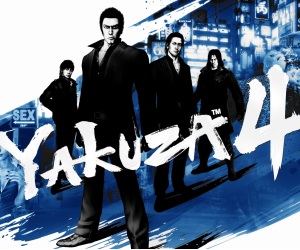 Game: Yakuza 4
Game: Yakuza 4
Developer: Team CS1
Publisher: SEGA
Available on: PlayStation 3 only
The life of a Japanese Gangster is a very busy one, but they still find time to play a quick ten frames of Bowling, or fit in a game of Poker. At least that is what SEGA and the Yakuza series have led us to believe. Now in its fourth instalment, the series seemingly goes from strength to strength, adding more and more features and improvements yet maintaining the quirky charm that populates it. The game is a massive hit in homeland Japan yet it is still only a cult favourite in Europe and America. Everything that sets it apart from other games and makes it unique also makes it hard to swallow for some gamers. But given a chance, can its ample charms and swathe of features will win you over?
STORY: After the ambitious multi-layered political drama that featured in Yakuza 3, the development team have wisely scaled back somewhat for this iteration. In the last game, a wide range of story threads and locations were loosely drawn together by an overarching plotline, but the course became unclear in the muddle. Yakuza 4 is much more tight-knit. The game is focused more clearly on gangland life and issues, whilst being centered on the same main location, the fictional area of Kamurocho; an accurate representation of the Tokyo Red-Light district. Characters will venture out to other locales, such as a high security prison or island holiday resort, but Kamurocho is the focal point.
The game once again focuses on many of the Yakuza groups and leaders who have been established in past titles. Luckily for the uninitiated, SEGA have included backstory compilations covering all previous Yakuza titles, that can be viewed by the player before starting the game. This is priceless as the series is very self referential and recurring characters are common. We join the game after a small scale gang scuffle goes horribly awry and turns into murder. With all of the gangs in the city interconnected, events snowball and a major Yakuza disagreement boils over into violence. One gang decides to use the events as an excuse to tip the balance of power in Tokyo, and in doing so, leave a trail of death and destruction.
The main difference between Yakuza 4 and its predecessors, is that players can now control four different characters. As well as controlling series protagonist Kazuma Kiryu – the former mob boss who turned to helping out disadvantaged kids before he was called back into action by his friends, users will also meet and gain control of; Shun Akiyama – a loan shark who was formerly a down-and-out, so he now helps those in need, Masayoshi Tanimura – an apparently corrupt cop who loves gambling but hides a caring side, and Taiga Saejima – a Yakuza assassin who escapes from prison after a 25-year stint.
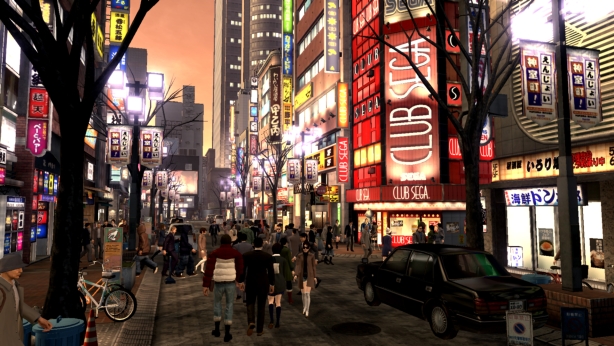
In essence, the game has four different storylines that converge at certain points, culminating in a combined final chapter. But rather than be quite disparate, as was the case with the previous title, these four plotlines all contain shared elements and threads that link them together fluidly. What you discover whilst playing as one character will directly inform what you have learned with another. You can’t switch between them at will, instead the developers retain control of the narrative and can direct the action between each story arc as and when the game flow is best suited. Whereas some sandbox games may sacrifice directorial control in favour of an open ended structure, the developers here have found a way of keep the gameplay in open world format, but made sure they still dictate the narrative flow.
This does, however, lead me to the main problem with the story. The pacing can really drag at times. As the different storylines develop and the different backstories are delved into, players could be forgiven for feeling like they haven’t actually done much for a while. There are large sections early on in the game that are dominated by long cutscenes and little in the way of gameplay. This does reduce once you get to know the characters better, but the very nature of a sandbox game is to stretch the game and pad out the experience with extra objectives. This gets in the way of the story progression to an extent and can make it difficult to follow or to remember what you should be doing, as sometimes three or four separate quests may be running simultaneously.
GRAPHICS: Presentation wise, whilst the title doesn’t make any major strides since the third game in the series, there has been some improvements. Using the same engine, just upgraded somewhat, the structure remains relatively unchanged. Menus and GUI art could have been ported over directly from the last game, but these aren’t really features that were likely to sell anyone on the game anyway. Character animation is incredibly impressive during automated cutscenes. The models display little subtleties in expression, and coupled with the full facial scans that are applied to each character from their actor, they really bring the characters to life. In-game and during interactive cutscenes (especially when involving non-player characters) the animation is still a little stiff and the lesser characters appear somewhat blocky in comparison to the main ones. This is understandable when your cast of extras numbers in the thousands.
The city itself is beautiful. It really is such an impressive and intricate representation of its real life counterpart. The city is lit by endless neon signs and populated by street performers, vendors, and an endless number of onlookers. The shops and items you can purchase all look authentic too. It is prefectly believable that all of these stores could exist in the real place. With the sheer number of Japanese product placement deals the game makes use of, there is an added layer of believability. This city really appears to be alive and portrays the hustle and bustle of Tokyo brilliantly. There is never the feeling that nothing is happening, there is always something going on in the city and it is a great achievement that the game handles the heavy burden of this demanding location so well. Frame rates are constant and the draw distance is very good for such a dense environment.
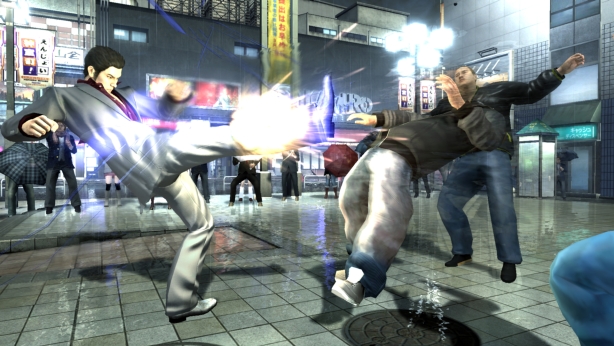
SOUND: The sound and music in the game provide yet more impressive features. As you take a stroll through Kamurocho the streets are alive with the sound of Pachinko machines and cuddly toy UFO Catchers. Every background noise and ambient sound you would expect to hear in the entertainment district of a busy metropolis is represented here. Just as you would expect, there is never a quiet moment. It is hard to describe how evocative it is to hear the sound of pins falling when approaching the bowling alley doors, or the echo of an aluminium baseball bat emanating from the batting cage. It makes you feel like you could really be there.
Unfortunately, voices are only used in cutscenes and sparingly here and there in gameplay. I say unfortunately because whilst voices remain in Japanese, with only subtitles translated to English, the voice acting helps recognisability. Hearing the actors speak, whether it is understandable or not, does effect the emotion and gravitas of a scene and in the automated cutscenes the intonation and emphasis laced on words and phrases helps add to the tension in a way it is hard to describe. Compare this to the silent subtitled gameplay (which would have been silent in the original Japanese version too) and you can see why full voices would have made the game much more involving. Simply reading the text loses so much of the impetus or meaning from the delivery and I can only hope that for the fifth game, full voices will be implemented throughout. Although with such a huge cast and hours upon hours of dialogue, one can see why SEGA don’t go down that route.
Finally, the music too is excellent. Ranging from slow, sad melodies for the more emotional moments, to fast, high-octane beats when the action kicks in, the composer has created such a varied soundtrack that includes (for example) cheesy elevator style music that is played in pharmacies and convenience stores, that both enhance the authenticity of the world, and heighten the emotion. I could only ask that there was a little more variety in the battle music, because if you consider the amount of random battles the player will encounter throughout the game, the same fighting tunes repeat on a very frequent basis.
GAMEPLAY: This is the area which will cause the most contention amongst fans. Has enough changed from game to game to justify the need for a fourth title? Whilst the core gameplay remains the same as it has ever been, a lot of other additions and tweaks have been introduced and they add a lot of depth and variety to the experience. Firstly, the inclusion of four players has also allowed for the addition of a series of different side-games or individual goals that each character works towards. On top of the main quest there are side-games which relate to the personality of each character in some way.
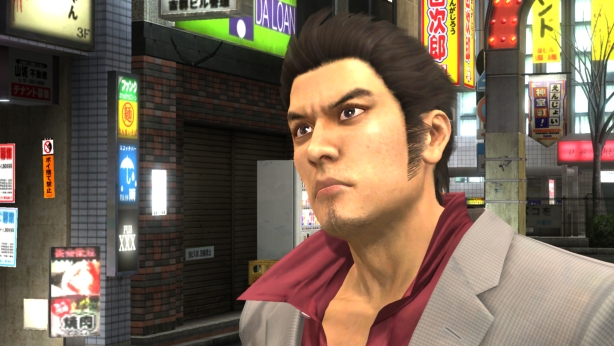
Akiyama, operator of Sky Finance Loans and owner of the Hostess Club Elise, is the only character who actually has two side-games. “Friendship”, whereby completing fetch quests or giving gifts to particular NPC’s dotted around Kamurocho, for example, will recruit them to be your friend and result in them helping you in battle by passing you a weapon, if you ever find yourself in trouble in their vicinity. As well as that, he can partake in the amusingly titled “Create a No. 1 Hostess!”. This is somewhat self-explanatory as Akiyama must scout for new talent for his club (which is a Japanese traditional club where men go for female companionship, nothing sexual), then dress them and train them up to become the most popular Hostess there. This side-game may appear to be brand new, however it did feature in Yakuza 3 in the original release, but was one of the items culled from the game when it was quickly translated into English. Along with such features as Mah-Jong and Massage Parlours, Hostess Clubs were seen as being too culturally specific to Japan and SEGA did not include them for Western audiences. Due to fan outcry, those same features have been included in the current title, and much for the better as they are very amusing mini-games and give a real insight into the often quirky Japanese culture. Hostess Clubs can also be accessed later to develop relationships with girls, and allow you to take them out to other locations on dates.
Ex-convict Saejima puts his fighting skills to good use as he must “Create a Fighter!” Here he works with a rookie fighter to train them up until they are able to compete in a series of tournaments. Limited to fifty rounds of training, you can work on the move set of the fighter and their attributes, to create the perfect balance needed for victory and to be able to win the tournament trophies. “Resolving Police Radio Disputes” involves Kanimura using his Police Scanner to listen in on callouts. As an incident report comes across on the radio, the young Policeman has to quickly find the location mentioned and protect the innocent. This helps us sympathise with him a bit more, as sometimes he comes across as quite an unlikeable guy, so these side-games help soften his image. Finally, when playing as Kazuma Kiryu, you can participate in the more straight-forward “Team Encounter Battle.” This is more or less self explanatory, as Kazuma takes on different gangs, working his way through the underlings until he can defeat the gang leader and move onto the next challenge. Each of these different side-games compliments what we already know about the particular character and the activity which is matched to each protagonist makes sense.
Aside from the side-quests and story progression, much of the game is made up of fighting. The mechanics for the fighting mode have changed very little from the first Yakuza game up until this version. Anyone who played the last PlayStation 3 title will be perfectly at home with it. Primary attacks are operated by one button, which, used in conjunction with a strong attack button can form impressive combos. There isn’t much variety in the basic combos though, so it is through levelling up and integrating weapons into your attacks that you can cause more damage. As you build experience through fights and quests, new attacks, recovery moves and taunts can be equipped, that will make your fighting more effective and help charge your Heat meter. Once the Heat meter is full, brutal face-smashing finishing moves can be executed that will take huge chunks off the energy bar of any opponent. These moves are not for the faint of heart, as the game can sway from the cartoon like hilarity of Hostess Clubs to the curb-stomping ugliness of these moves. Throws and grabs are also accessible, but once again the basic moves are poor, and only once you have levelled up will these do any real damage, although throwing an opponent into a whole crowd of enemies is an effective tactic.
The main forward step in terms of fighting is that each of the four playable characters have a different fighting style and set of moves. Akiyama is a speedy fighter, favouring Tae-Kwon-Do but rarely using his fists. Tanimura is a Judo fighter, but also specialises in weapons and has strong technique. Saejima follows no particular style, but is a powerful brawler, often using throws and is able to pick up larger weapons and opponents that the other three fighters cannot. Last but not least, Kazuma is a good all-rounder, proficient in Mixed Martial Arts, but also with a great amount of power.

Other side quests include “Haruka’s Wish”, which featured in the last game and involves Kazuma and his adopted daughter. Throughout the game you will be given the chance to spend time with Haruka around the city, and the more you make her happy and fulfill her requests, the more trust the two of you will build up. Reach particular trust checkpoints and you will be rewarded with rare power-up items. Anyone who played the chase side-quests last time around may have gotten a little bit irritated, so the development team have tweaked these sequences, allowing auto-sprint, so players don’t have to concentrate on too many different controls at once. They have also implemented the use of weapons and projectile objects in chase mode, so if your target is getting too far away you can launch an item at them to slow them down. You won’t always be the chaser however, as sometimes you may find the Police on your tail for instance. This time around, if someone gets too close to you, your character can pull off a “heat move” to eliminate that pursuer permanently. Locker Key pick-ups also make a return. Scattered around town are glowing locker keys, which when can be used to open a bank of lockers, filled with useful items such as power-ups and materials used at the gun shop for customising your weapons.
To make the city just that little bit bigger and to add even more content to the game, you can now access rooftop levels and go underground into the sewers and an underground shopping arcade. This is a good move, as it keeps the action in Kamurocho still, but allows more space for specialist shops and mission locations. One example of this is a rooftop chase, where Akiyama must escape the Police. Jumping from rooftop to rooftop and running down flights of stairs is like something straight from a Hong Kong action movie and really adds a different dynamic to the mission list.
When you have a city that is so big and is waiting to be explored, the game demands a good map or fast travel system. Unfortunately, as was the case in Yakuza 3 as well, this game has neither of those. Firstly, there is no fast travel, which, whilst understandable as it does destroy the idea of exploring the city somewhat, would have been appreciated for some of the times when you might have to travel from one side of the city to another, once you have already got quite far into the game and know what the city is all about. Secondly, the on-screen mini-map and the full map in the pause menu are both somewhat unclear. You can look at what different shops or locations are found in the metropolis and where they are located on the map, but as soon as you leave the pause menu, you have no idea where they are as you cannot set markers or waypoints of your own. Side quests are rarely marked on the map either, only core quests have radar points to follow. This does make navigating the huge area a bit of a tall task at times, but this will get easier once you learn the lie of the land.
These side missions are rounded out by the extensive array of mini-games. The series is famous for including a host of both mundane and insane mini-games that you can spend you money on, or earn more money from. These can be frustrating, but are nice distractions and the fact that the world is so full of these different opportunities does increase the already great feeling of being immersed in another world. The full list of mini-games, including several which are new in this game, is as follows: Underground Fighting Tournament, Massage Parlour, Billiards, Black Jack, Poker, Baccarat, Roulette, 10-pin Bowling, Darts, Hot Springs Bath House, Table Tennis, Fishing, Karaoke, Golf, Pachinko, Shogi, Mah-jong, Chinchirorin, Cho–han, Koikoi (the previous five are all Oriental Card Games), Batting Cage, UFO Catcher and Arcade games Boxcelios 1 and Boxcelios 2. You can see how the great variety of different activities would mean that if you are ever bored with the core quests, players can always take a break and there will be something new to try.
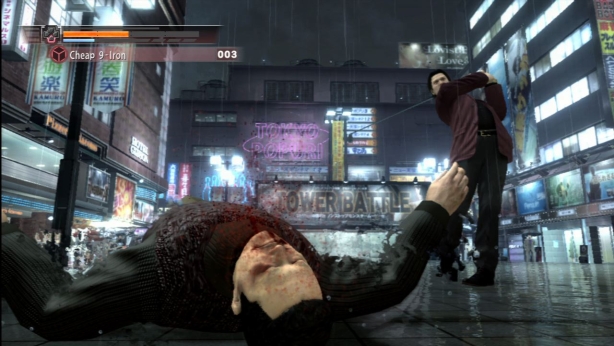
There is little multiplayer support in the title, but more than there has been in the past. Firstly, for games such as bowling and the in-game arcade machines, online leaderboards have been implemented which allow players to compare and compete with other gamers around the world to attain the highest score in their chosen mini-games. This adds to the competitive nature somewhat, but only in as far as leaderboards usually can.
Aside from that, some of the mini-games in the title can be unlocked for two player couch play. For example, earn a PSN Trophy in the bowling game in single player and you and a friend will be able to compete with one another on the same console in the bowling lanes. All of these are fairly basic competitive games, but it does add a little something extra to help occupy your time. It is unlikely to think, however, that players would want to put aside the single player campaign to simply play some two player golf.
LONGEVITY: Add the multiplayer modes in with the extensive single-player mode and this game is gigantic. The core missions for all four characters are generous and will take a good four hours or more each, so you would be looking at forty to fifty hours of play before you even contemplate the optional side quests and mini-games, as well as trying to achieve all of the PSN Trophy requirements that are available. It is doubtful anyone would feel very inclined to play the main mode through more than once, but with the immense number of activities open to you, I doubt anyone would need to. There is so much to occupy your time, the game is virtually endless.
VERDICT: Past deficiencies have been worked on and tweaked to provide a more enjoyable game. But has the series really moved on since it first launched? Many of the features described here have changed very little over the years and some people who do give the game a chance will feel serious deja-vu. These people are unlikely to find the merits enough to come back again. New players too will be put off by the slow pace and some of the seemingly mundane activities. The fighting will seem too simple for many, but it is deep when you give it time.
The key here is time, and this game will take over your life if you commit fully to it, as it is gigantic. But as is often the case, a slow burner gets good if you are patient. It is an epic movie that demands you play it as the creators intended. The story is very well written and involving, despite the length, and the action does start to become non-stop with breakneck pace as the story reaches its climax and the truly cinematic vision of the development team takes shape. It may not have the nuance and style of Heavy Rain for example, or the Bombastic pomp of Metal Gear Solid, but this very Japanese affair has a unique charm all of its own. These gangsters really do put forward an offer you shouldn’t refuse.







